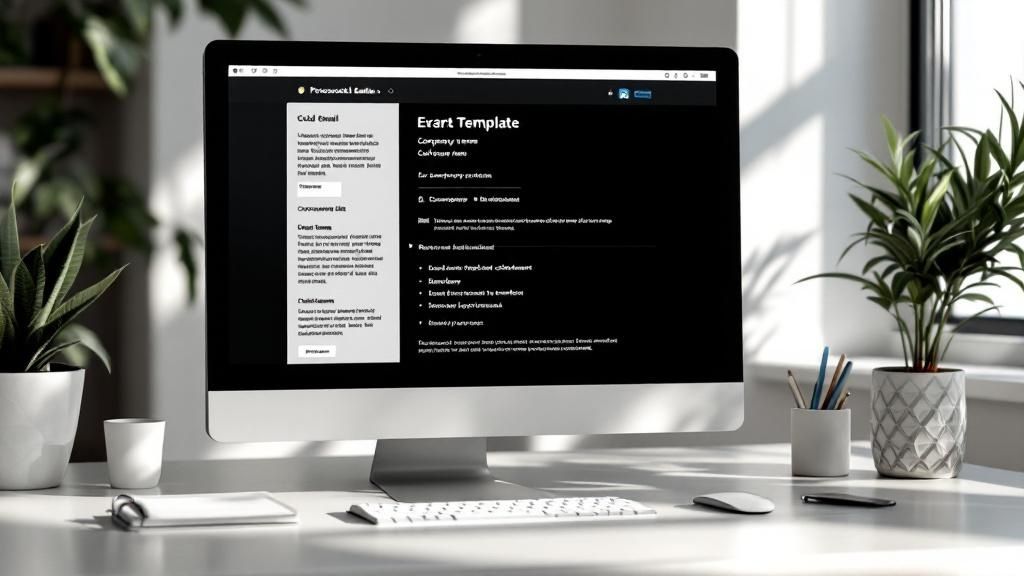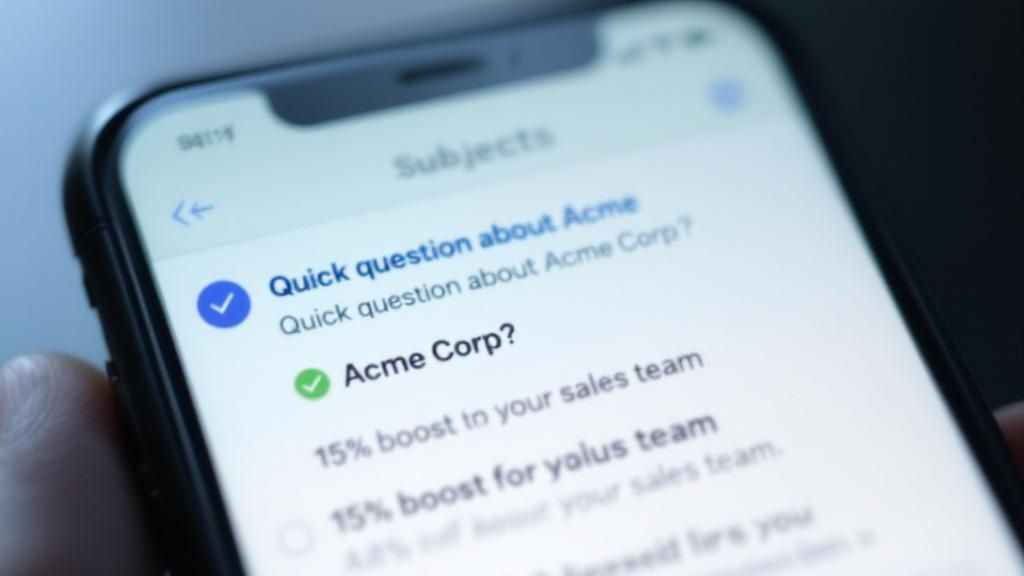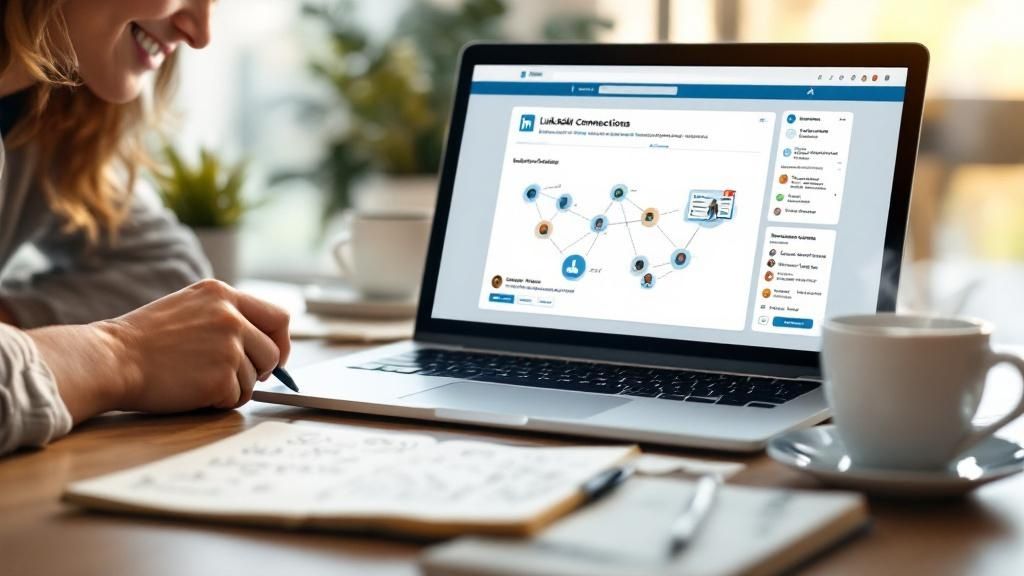Beyond the Cold Call: Mastering Email for Warm Connections
Stop sending cold emails that land in the spam folder or get instantly deleted. This isn't about blasting generic messages; it's about crafting targeted outreach that resonates. This listicle reveals eight cold email best practices to transform your approach and generate real connections. Whether you're a solo freelancer, part of a sales team, or managing outreach for a large enterprise, these strategies are essential for achieving measurable results. We'll cut through the noise and provide actionable insights you can implement immediately. Learn how to personalize at scale, optimize for deliverability, and create emails that convert.
This in-depth guide covers crucial aspects of effective cold emailing, including:
- Personalization: Discover techniques to connect with individuals even within large-scale outreach.
- Subject Lines: Craft compelling subject lines that grab attention and boost open rates.
- Value-Driven Content: Learn to prioritize value and position your offering as a solution.
- Call to Action: Develop clear and compelling CTAs that encourage recipients to engage.
- Timing and Frequency: Send emails at the optimal time and frequency to maximize impact.
- Mobile Optimization: Design emails that render perfectly on any device.
- Social Proof: Leverage testimonials and data to enhance credibility and build trust.
- Deliverability: Implement strategies to ensure your emails reach the intended inbox.
Mastering these cold email best practices is crucial for cutting through the digital clutter and forging meaningful connections. This article will empower you to build relationships, generate leads, and ultimately, drive business growth. No more generic blasts – let's dive into the specifics of effective, personalized cold email outreach.
1. Personalization at Scale
Personalization at scale is a crucial cold email best practice. It transforms generic outreach into targeted communication that resonates with recipients. This approach moves beyond simply inserting a prospect's name. It involves researching their company, role, recent achievements, and challenges to craft relevant and engaging messages. This demonstrates genuine interest and positions you as a valuable resource rather than just another salesperson.

Why Personalization Matters in Cold Email
Generic cold emails often end up in the trash. Personalized emails, however, demonstrate that you've taken the time to understand the recipient's context. This significantly increases the likelihood of engagement and positive responses. It positions you as a thoughtful communicator, not just a sender of mass emails.
Examples of Effective Personalization
Personalization can take many forms. Here are a few examples:
- Referencing a recent company funding round: "Congratulations on your recent Series A funding! I'm reaching out because…"
- Mentioning a specific challenge discussed on LinkedIn: "I saw your post about the challenges of [specific challenge]. We've helped other companies in the [industry] overcome similar hurdles by…"
- Congratulating on a recent promotion or company milestone: "I noticed your recent promotion to [new role]. Congratulations! This made me think of how we could help you…"
- Connecting your solution to their specific industry trends: "Given the recent shift towards [industry trend], I thought you might be interested in how our solution can help [company name]…"
Actionable Tips for Personalization at Scale
Implementing personalization effectively requires a strategic approach:
-
Utilize Research Tools: Leverage tools like LinkedIn Sales Navigator, Clearbit, or ZoomInfo to gather valuable insights about your prospects efficiently. These platforms offer detailed information on company news, individual roles, and industry trends.
-
Create Personalization Templates: Develop templates for common scenarios, such as congratulating a prospect on a promotion or referencing a recent company achievement. This streamlines your process while maintaining a personalized touch.
-
Focus on Business Relevance: Prioritize business-related personalization over personal details. While acknowledging a recent marathon finish might seem friendly, focusing on their company's recent market expansion demonstrates a deeper understanding of their priorities.
-
Limit Personalization Details: Avoid overwhelming the recipient with excessive personalization. Two to three specific, relevant details are sufficient to show genuine interest without appearing overly researched or intrusive.
When and Why to Use This Approach
Personalization at scale is particularly effective when targeting high-value prospects or decision-makers. It's ideal for scenarios where building rapport and demonstrating a deep understanding of the prospect's needs are crucial for success. This approach is a cornerstone of cold email best practices because it significantly improves open rates, click-through rates, and ultimately, conversion rates. By showcasing your research and tailoring your message, you elevate your cold outreach from generic spam to valuable communication, setting the stage for meaningful business relationships.
2. Compelling Subject Line Optimization
Compelling subject line optimization is a critical cold email best practice. It's the art and science of crafting email subject lines that grab attention, pique curiosity, and entice recipients to open your message without triggering spam filters. This involves understanding psychological triggers, prioritizing brevity, and rigorously testing different approaches to maximize open rates while accurately reflecting the email's content. A well-crafted subject line is the gateway to a successful cold email campaign.

Why Subject Line Optimization Matters in Cold Email
Your subject line is the first, and often only, impression you make on a prospect. A weak or generic subject line will likely be ignored, landing your carefully crafted email directly in the trash. A compelling subject line, on the other hand, can significantly increase your open rates, giving your message a chance to connect with the recipient.
Examples of Effective Subject Lines
Effective subject lines often employ proven techniques:
- Question Format: "Quick question about [Company]'s [specific challenge]?"
- Curiosity Gap: "[Prospect name], thoughts on this?"
- Value Proposition: "15% increase in [relevant metric] for [similar company]"
- Social Proof: "[Mutual connection] suggested I reach out"
Actionable Tips for Subject Line Optimization
Optimizing your subject lines requires a strategic and iterative process:
-
Avoid Spam Trigger Words: Steer clear of words like "free," "urgent," or excessive punctuation. These can trigger spam filters and damage your sender reputation.
-
Test Different Approaches: Experiment with various subject line styles and track their performance. A/B testing can help you identify what resonates best with your target audience.
-
Utilize Preview Text: Treat your preview text as an extension of your subject line. This provides additional context and can further entice recipients to open.
-
Mobile Optimization: Keep subject lines concise for mobile viewing (around 30-40 characters for optimal visibility).
-
Personalization: Incorporate personalization elements when relevant, but avoid overusing the prospect's name.
When and Why to Use This Approach
Compelling subject line optimization is essential for every cold email campaign. It's particularly important when targeting busy decision-makers who receive a high volume of emails daily. By crafting subject lines that are concise, intriguing, and relevant, you significantly improve your chances of getting your email read. Learn more about Compelling Subject Line Optimization. This is a foundational element of cold email best practices because it directly influences open rates, which in turn affects click-through rates and conversions. Ultimately, mastering this practice is crucial for achieving cold email success and generating meaningful leads.
3. Value-First Approach
The value-first approach is a cold email best practice that prioritizes providing immediate value to prospects. Instead of leading with a sales pitch, you offer helpful insights, resources, or solutions to their problems. This establishes credibility and reciprocity, fostering engagement and relationship building that naturally paves the way for future sales conversations. It positions you as a trusted advisor rather than just another salesperson.

Why a Value-First Approach Matters in Cold Email
Traditional sales-focused cold emails often get ignored. A value-first email, however, demonstrates genuine interest in helping the prospect. This increases the likelihood of a positive response and builds trust, a key element for long-term business relationships. To create compelling subject lines that grab attention, you might explore strategies for crafting effective subject line for connecting with recruiters. This article covers how to create a great subject line in the context of recruiter outreach.
Examples of a Value-First Approach
Providing value can take many forms. Here are some examples:
- Sharing a relevant industry benchmark report with personalized insights: This demonstrates your expertise and provides valuable data they can use.
- Offering a free audit or assessment of their current processes: This identifies potential areas for improvement and positions you as a problem-solver.
- Introducing them to a potentially valuable business contact: This facilitates networking and builds goodwill.
- Providing a custom analysis of their competitive landscape: This offers strategic insights and shows you understand their market.
Actionable Tips for a Value-First Approach
Implementing a value-first approach effectively requires preparation and follow-through:
-
Create valuable content libraries: Develop resources like templates, checklists, or white papers that can be easily customized for different prospects.
-
Focus on actionable insights: Avoid generic information. Provide specific advice or data that prospects can immediately apply.
-
Use value as a soft qualification method: Gauge prospect engagement with your value offering to identify those genuinely interested in your services.
-
Follow up value delivery with specific, relevant questions: This initiates a conversation and encourages further interaction.
-
Track which types of value resonate most with different prospect segments: Refine your approach based on data and feedback to maximize effectiveness.
When and Why to Use This Approach
The value-first approach is particularly effective for complex sales cycles or high-value prospects where building trust and rapport is essential. It's a cornerstone of cold email best practices because it fosters genuine connections. This approach is a long-term strategy that focuses on building relationships and establishing your expertise, ultimately leading to higher conversion rates and stronger client relationships. This method differentiates your cold outreach from generic sales pitches, transforming it into a valuable resource for potential clients. It establishes you as a thought leader and trusted advisor in their industry, setting the stage for successful, mutually beneficial partnerships.
4. Clear and Specific Call-to-Action (CTA)
A clear and specific call-to-action (CTA) is a critical element of effective cold emails. It directs the recipient towards the desired next step, transforming a passive reader into an active participant. This involves using precise language, minimizing friction, and providing crystal-clear instructions. It also requires maintaining a professional tone that respects the prospect's time and decision-making process. This best practice ensures your message doesn't just inform but also inspires action.
Why a Strong CTA is Essential in Cold Email
A vague or absent CTA leaves the recipient unsure of what to do next, often leading to inaction and a lost opportunity. A strong CTA, however, provides clear direction, making it easy for the prospect to engage and move forward in the sales process. It eliminates ambiguity and facilitates a smoother transition towards the next stage of interaction.
Examples of Effective CTAs in Cold Emails
Here are examples of CTAs that effectively prompt engagement:
- Specific Time Commitment: "Are you available for a 15-minute call this Thursday or Friday afternoon?"
- Benefit-Oriented Approach: "Would a brief 5-minute conversation make sense to explore how we can help you achieve [specific goal]?"
- Value-Driven Offer: "Could I send you a 2-minute case study showcasing similar results we've achieved for companies like yours?"
- Direct Scheduling Request: "What's the best way to get 10 minutes on your calendar this week to discuss your current challenges with [specific area]?"
Actionable Tips for Crafting Compelling CTAs
Creating effective CTAs requires a strategic approach:
-
Use Specific Time Commitments: Instead of suggesting a "quick call," propose a specific duration like "15 minutes." This manages expectations and respects the prospect's time.
-
Offer Specific Time Options: Provide two or three concrete time slots rather than an open-ended request. This reduces the back-and-forth and simplifies scheduling.
-
Focus on Prospect Benefit: Frame your CTA around the value you offer the prospect, not your own needs. Highlight how engaging with you will benefit them.
-
Use Action-Oriented Language: Employ verbs that encourage action, such as "download," "register," or "schedule." This creates forward momentum.
-
Test Different Commitment Levels: Tailor the level of commitment requested in your CTA to the prospect's stage in the sales funnel. A less demanding CTA might be more appropriate for initial outreach.
When and Why to Use This Approach
A clear and specific CTA is essential in every cold email. It's a fundamental element of effective cold email best practices, driving engagement and progressing the sales process. Whether you're aiming to schedule a call, share a resource, or simply initiate a conversation, a well-crafted CTA is crucial for converting passive recipients into active leads. This approach maximizes your chances of eliciting a positive response and building valuable business relationships. By making it easy for prospects to take the next step, you pave the way for meaningful interactions and ultimately, successful outcomes.
5. Strategic Email Timing and Frequency
Strategic email timing and frequency is a systematic approach to maximizing cold email effectiveness. It involves determining the optimal send times, designing effective follow-up sequences, and establishing appropriate contact frequency. This isn't about bombarding prospects; it's about respectful persistence that nurtures potential relationships. It hinges on understanding when prospects are most likely to engage, leveraging data-driven insights, and adhering to industry best practices. Optimizing email timing is crucial; this resource delves into the best time to send cold emails.

This infographic illustrates the process flow for strategic email timing, encompassing optimal send times, multi-touch sequencing, and value-driven follow-ups. The visualization emphasizes the importance of a structured approach, starting with identifying the best times to reach prospects, progressing through a planned sequence of touches, and consistently providing valuable content in follow-ups.
Why Timing and Frequency Are Crucial
Delivering your message at the right time, with the right frequency, dramatically improves the chances of it being seen and acted upon. A well-timed email can land in a less cluttered inbox, increasing its visibility. Consistent, value-driven follow-ups demonstrate genuine interest and keep your solution top-of-mind.
Examples of Effective Timing and Frequency Strategies
- Targeting B2B executives: Sending emails Tuesday-Thursday between 10 AM and 12 PM often yields higher open rates.
- Implementing a multi-touch sequence: A 5-7 touch sequence over 3-4 weeks, each with a different angle, can effectively nurture leads.
- Leveraging event-triggered follow-ups: Sending targeted emails after a prospect visits your website or downloads content demonstrates responsiveness.
- Considering seasonal timing: Aligning outreach with budget cycles or industry events can increase relevance.
Actionable Tips for Optimizing Email Timing and Frequency
- Test and Analyze: Don't rely on generic best practices. Test different send times with your specific audience and analyze the results.
- Space Follow-Ups Strategically: Space follow-ups 3-7 days apart for optimal persistence without being annoying.
- Vary Your Message: Provide diverse value propositions and angles in your follow-up sequence.
- Automate with Personalization: Use automation tools but maintain a personalized touch in each message.
- Include Breakup Emails: End your sequence with a breakup email to gracefully exit the conversation if necessary.
When and Why to Use This Approach
Strategic email timing and frequency are essential for any cold email campaign. This approach helps to maximize engagement and conversions. It's particularly beneficial for nurturing leads, building relationships, and staying top-of-mind. Learn more about Strategic Email Timing and Frequency. This cold email best practice ensures your messages reach the right people at the right time, significantly impacting your overall outreach success. By strategically timing your emails and following up appropriately, you transform cold outreach into a respectful, effective communication strategy.
6. Mobile-First Email Design
Mobile-first email design is a critical cold email best practice. It prioritizes designing and formatting emails for optimal viewing on mobile devices, recognizing that a significant majority of emails are opened on smartphones and tablets. This approach involves optimizing subject lines, email length, formatting, and call-to-action placement for small screen engagement and touch-based interaction. It's no longer enough to simply be mobile-friendly; your cold emails must be designed with the mobile user as the primary focus.
Why Mobile Optimization Matters in Cold Email
Over 60% of emails are opened on mobile devices. Ignoring this statistic means potentially alienating a large portion of your target audience. A poorly formatted email on mobile can lead to frustration, immediate deletion, and missed opportunities. Mobile-first design ensures your message is clear, readable, and actionable, regardless of the device used.
Examples of Effective Mobile-First Design
Here are some key elements of a mobile-optimized cold email:
-
Concise Subject Lines: Subject lines should be under 50 characters to ensure full visibility on mobile screens. For example, instead of "Introducing a Revolutionary New Solution for Streamlining Your Workflow," try "Boost Workflow Efficiency."
-
Clear Paragraph Breaks: Use short paragraphs (2-3 sentences maximum) to enhance readability on smaller screens. Large blocks of text can be daunting on mobile.
-
Prominent Call-to-Action: Use a single, prominent call-to-action button rather than multiple links scattered throughout the email. This makes it easier for recipients to take the desired action on their mobile device.
Actionable Tips for Mobile-First Design
Implementing mobile-first design requires a shift in perspective:
-
Test on Multiple Devices: Test your emails on various mobile devices and email clients to ensure consistent rendering and functionality. Don't just rely on one device or emulator.
-
Strategic Preheader Text: Use preheader text effectively to complement your subject line and provide additional context. This valuable real estate can significantly impact open rates.
-
Optimal Email Width: Keep email width under 600 pixels for optimal mobile viewing. This prevents horizontal scrolling and ensures the entire email is easily visible.
-
Larger Font Sizes: Use larger fonts (14px minimum) for mobile readability. Small fonts strain the eyes and detract from the message.
-
Thumb-Friendly CTAs: Place call-to-action buttons prominently and make them large enough to be easily tapped with a thumb.
When and Why to Use This Approach
Mobile-first design is essential for all cold email campaigns. Given the prevalence of mobile email usage, it's no longer a "nice-to-have" but a "must-have." This approach is crucial for maximizing open rates, click-through rates, and ultimately, conversions. By prioritizing the mobile experience, you ensure your message is accessible, engaging, and effective for the majority of your recipients, increasing your chances of achieving your cold email goals and establishing valuable business connections. Ignoring mobile optimization is equivalent to ignoring a significant portion of your potential market.
7. Social Proof and Credibility Building
Social proof and credibility building are essential cold email best practices. They leverage the psychological principle that people are more likely to take action when they see others have done so successfully. Incorporating elements like customer testimonials, case studies, mutual connections, company credentials, and industry recognition can significantly reduce prospect skepticism and increase engagement. This transforms your cold outreach from an anonymous solicitation into a trusted communication.
Why Social Proof Matters in Cold Email
Cold emails often face an uphill battle against skepticism and distrust. Prospects are bombarded with generic messages, making them wary of unsolicited outreach. Social proof combats this by providing tangible evidence of your value proposition. It reassures prospects that others have benefited from your product or service, increasing the likelihood of them considering your offer.
Examples of Effective Social Proof
Several methods can effectively incorporate social proof into your cold emails:
- Quantifiable Results: "We helped [Similar Company] increase [relevant metric] by 40% in 6 months."
- Mutual Connections: "[Mutual Connection] mentioned you might be interested in our approach to [challenge]."
- Industry Recognition: "As seen in [Industry Publication] or winner of [Relevant Award]."
- Brief Case Study Snippet: Include a concise, relevant case study snippet tailored to the prospect's industry or challenge.
Actionable Tips for Building Credibility
Implementing social proof effectively requires a strategic approach:
-
Use Specific, Quantifiable Results: Avoid vague claims like "increased sales." Instead, use concrete numbers and metrics to showcase the impact of your solution.
-
Match Social Proof to the Prospect: Tailor your social proof to the prospect's industry, company size, or role whenever possible for maximum relevance.
-
Keep it Brief and Relevant: Don't overload your email with lengthy testimonials. Keep social proof elements concise and directly related to your main message.
-
Obtain Proper Permissions: Always get permission before using customer names, logos, or specific results in your social proof.
-
Update and Rotate Proof Elements: Regularly refresh your social proof to keep it current and demonstrate ongoing success.
When and Why to Use This Approach
Social proof is particularly effective when targeting new prospects or entering a new market. It's ideal for building trust and establishing credibility quickly. This approach is a crucial cold email best practice because it addresses the inherent skepticism associated with unsolicited outreach. By showcasing your past successes and leveraging the influence of others, you significantly improve the chances of your message resonating with prospects and converting them into engaged leads. This builds trust and fosters a positive first impression, setting the stage for a productive business relationship.
8. Compliance and Deliverability Optimization
Compliance and deliverability optimization are essential cold email best practices. They ensure your emails reach prospects' inboxes instead of being flagged as spam. This involves adhering to legal requirements like CAN-SPAM and GDPR, following email service provider guidelines, and implementing technical best practices. Maintaining a clean sender reputation and avoiding spam filters is crucial for successful cold outreach.
Why Compliance and Deliverability Matter in Cold Email
Reaching the inbox is the first hurdle in cold emailing. Non-compliant or poorly delivered emails damage your sender reputation, leading to lower open rates and potentially blacklisting. By prioritizing compliance and deliverability, you maximize your chances of your message being seen and considered by your target audience. Learn more about Compliance and Deliverability Optimization.
Examples of Effective Compliance and Deliverability Practices
Several practices contribute to optimal email deliverability:
- Clear Sender Information: Include your company's physical address and easily identifiable sender information.
- One-Click Unsubscribe: Provide a clear and simple unsubscribe option in every email.
- Reputation Monitoring: Regularly monitor your sender reputation using tools like Sender Score.
- GDPR Compliance: Implement GDPR-compliant consent mechanisms for EU prospects.
Actionable Tips for Optimizing Compliance and Deliverability
Improving your email deliverability requires a proactive approach:
-
Warm-Up New Email Addresses: Gradually increase sending volume from new email addresses to establish a positive sending history.
-
Monitor Deliverability Metrics: Track key metrics like bounce rate and spam complaints to identify and address potential issues.
-
Use Reputable Email Service Providers: Choose providers known for good deliverability and infrastructure.
-
Maintain Clean Email Lists: Regularly remove invalid and inactive email addresses to improve list hygiene.
-
Clear Identification: Include clear identification and contact information in all emails.
When and Why to Use This Approach
Compliance and deliverability optimization are essential for all cold email campaigns. Neglecting these aspects can severely hinder your outreach efforts, regardless of how well-crafted your message is. These practices are fundamental to cold email best practices, ensuring your messages reach their intended recipients and contribute to a positive sender reputation. By prioritizing compliance and deliverability, you establish a foundation for successful cold outreach, maximizing your chances of engagement and conversions.
Cold Email Strategies Comparison Table
| Strategy | Implementation Complexity 🔄 | Resource Requirements 💡 | Expected Outcomes 📊 | Ideal Use Cases 💡 | Key Advantages ⭐⚡ |
|---|---|---|---|---|---|
| Personalization at Scale | High 🔄🔄 | Significant research tools & data 💡 | 30-50% higher open rates, 3-5x response 📊 | Targeted B2B outreach needing high engagement | Builds trust, credibility, reduces spam perception ⭐ |
| Compelling Subject Line Optimization | Low to Medium 🔄 | Minimal; creativity & testing tools 💡 | 20-25% open rates, 12-26% lift with personalization 📊 | Quick open rate improvement for cold outreach | Cost-effective, fast to test and iterate ⚡ |
| Value-First Approach | Medium to High 🔄🔄 | Expertise and content creation 💡 | 40-60% higher response, longer engagement 📊 | Relationship building with complex sales cycles | Establishes trust, credibility, reciprocity ⭐ |
| Clear and Specific Call-to-Action (CTA) | Low to Medium 🔄 | Minimal, requires testing 💡 | 371% response increase with specific CTAs 📊 | Emails needing clear next step and high response | Reduces decision paralysis, boosts response rates ⚡ |
| Strategic Email Timing and Frequency | Medium 🔄🔄 | Automation & tracking systems 💡 | 23% higher opens, 300% more responses 📊 | Multi-touch campaigns respecting prospect timing | Maximizes visibility, maintains engagement ⭐ |
| Mobile-First Email Design | Medium 🔄 | Design and testing across devices 💡 | 15% higher CTR on mobile, 68% email opens on mobile 📊 | Audience with high mobile usage, B2C & B2B alike | Ensures readability, improves mobile engagement ⚡ |
| Social Proof and Credibility Building | Medium 🔄 | Customer input, case study prep 💡 | 34% higher response, 70% increase with mutual refs 📊 | Building trust, overcoming prospect skepticism | Significantly reduces resistance, builds trust ⭐ |
| Compliance and Deliverability Optimization | Medium to High 🔄🔄 | Technical setup & monitoring tools 💡 | Inbox placement >85%, bounce <2%, spam <0.1% 📊 | Any email campaign needing legal & technical compliance | Protects reputation, ensures inbox delivery ⭐ |
Elevate Your Outreach: Putting Cold Email Best Practices into Action
This comprehensive guide has explored eight crucial cold email best practices, providing actionable insights to transform your outreach strategy. From crafting compelling subject lines that grab attention to implementing a mobile-first design that caters to on-the-go professionals, each element plays a vital role in maximizing your cold email success. Remember, the core of effective cold emailing lies in delivering genuine value, building trust, and fostering meaningful connections.
Key Takeaways for Cold Email Success
Let's recap the most important takeaways to ensure your cold emails resonate with your target audience and generate tangible results:
- Personalization: Move beyond simply inserting a name. Tailor your message to each recipient's specific needs and pain points.
- Value-Driven Messaging: Focus on how your product or service solves a problem for the recipient. Lead with value, not a sales pitch.
- Clear Call to Action: Guide recipients towards the desired next step with a concise and compelling call to action.
- Mobile Optimization: Ensure your emails are easily readable and navigable on mobile devices.
Implementing Best Practices for Long-Term Growth
Mastering cold email is an ongoing process of refinement and adaptation. Continuously analyze your metrics, experiment with different approaches, and stay updated on industry best practices. This iterative approach allows you to optimize your strategy over time and achieve sustainable growth. To ensure your cold emails don't end up in the spam folder, focus on compliance and deliverability, implementing proven email marketing best practices like those listed in this article. This includes adhering to regulations, maintaining a clean email list, and monitoring your sender reputation. These practices, coupled with a robust email marketing strategy (Source: 10 Email Marketing Best Practices for 2025 from OKZest), will help you build a strong foundation for successful cold outreach.
The Power of Cold Email in a Digital World
In today's competitive landscape, cold email remains a powerful tool for connecting with potential clients, generating leads, and driving business growth. By prioritizing personalization, value, and technical optimization, you can leverage cold email to achieve remarkable results and build lasting relationships.
Next Steps: Transforming Your Cold Email Strategy
Start by auditing your current cold email approach. Identify areas for improvement and implement the best practices outlined in this article. Focus on crafting targeted messages that resonate with your audience and provide genuine value. Track your key metrics, such as open rates, click-through rates, and conversion rates, to measure your progress and refine your strategy over time.
By embracing these cold email best practices, you can unlock the full potential of this powerful marketing channel and achieve lasting success in the digital age. Ready to streamline your cold email outreach and boost your sales performance? Explore Salesloop.io, a powerful platform designed to help you implement these best practices effectively. Salesloop.io offers features for personalization at scale, automated follow-ups, and detailed analytics, empowering you to optimize your cold email campaigns and achieve remarkable results.





